A better image of comet C/2001 L4 PanSTARRS. The comet is moving slowly near the north celestial pole, still a nice object for observation through much of the night for any northern hemisphere observer.
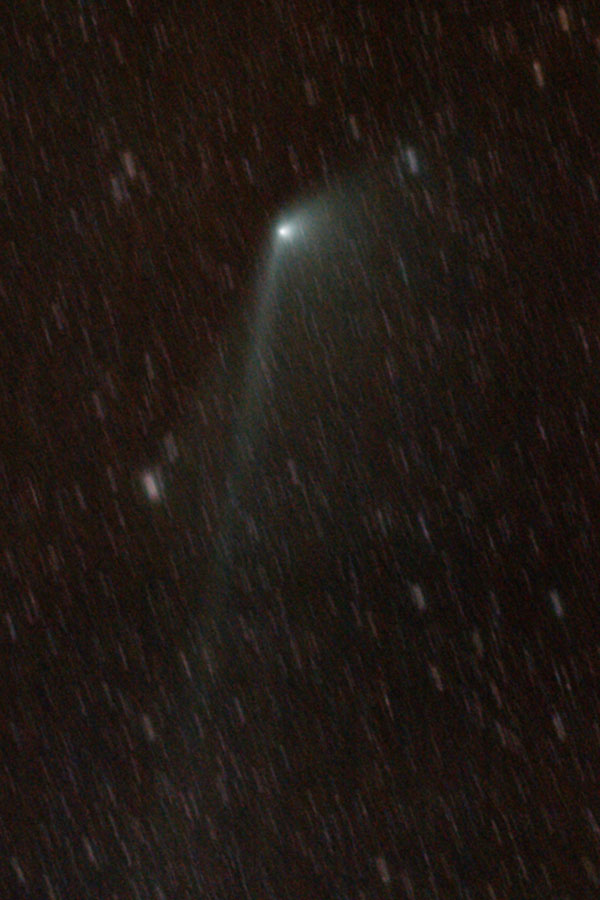
When you want to see the stars, find someplace dark
Well past perihelion comet C/2011 L4 continues to put on an impressive show. Amateur sky-watchers have been enjoying the impressive anti-tail reaching out a few degrees from the coma. True, you may need a telescope or at least good binoculars to see the comet. It may be dimming, but still worth the effort to observe.

The weather finally broke, leaving a clear western sky and a chance to photograph the comet. I set up and managed just a few shots before the comet set into the top of a tree across the street.
At least I was able to get on-sky. Much more than can be said about our ‘scopes on the mountain. Observing was cancelled earlier this afternoon, there is too much ice on the domes to operate safely. At least the ice was pretty, and photogenic.
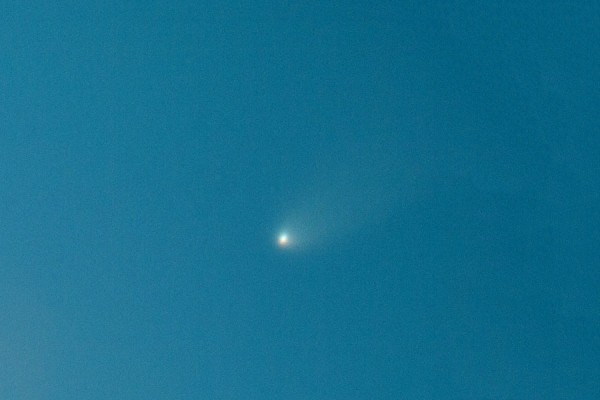
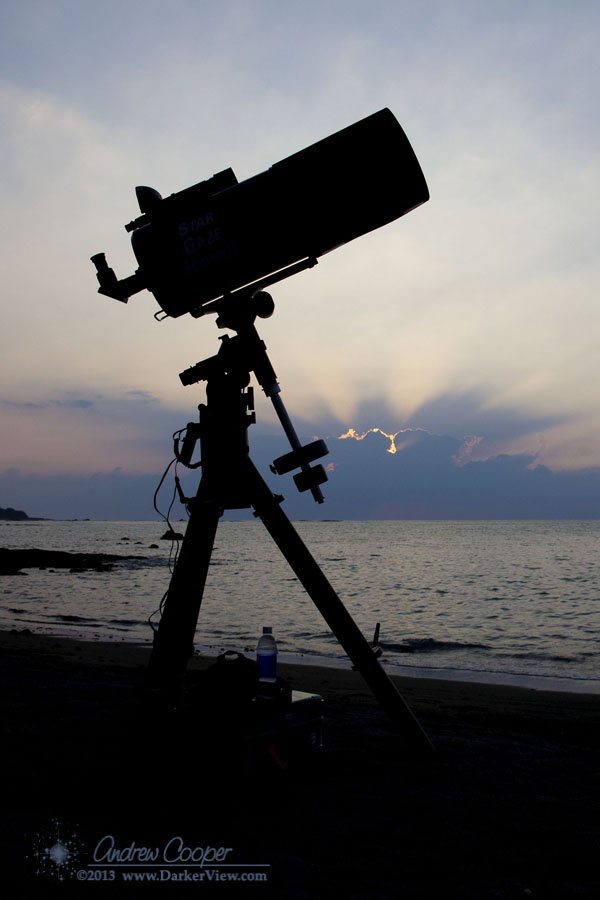
So, the comet is to be positioned right next to a pretty crescent moon this evening, a perfect photo opportunity. What are my chances of seeing it? Pretty much nil.
Will have to wait for the photos from my friends in Arizona.
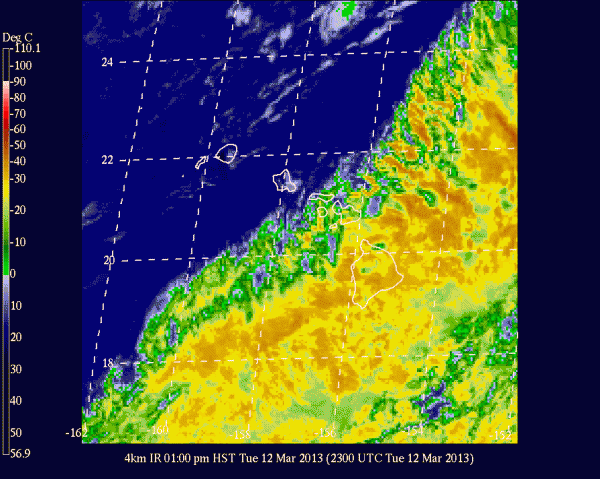
Today Comet C/2011 L4 (Pan-STARRS) will pass through perihelion, its closest approach to the Sun. Take a good look now, given the 110,000 year orbital period, the comet will not be back anytime soon.
The comet should be visible as a 1st magnitude object 13° above the horizon at sunset and directly above the glow of the setting Sun. It will climb higher each evening after passing through perihelion. It will begin to fade as well, most likely dimming below 4th magnitude by the end of March.

Now for a truly awful comet image.
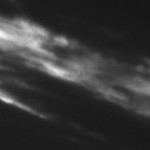
It had been wonderfully clear all afternoon. It was just as the sky darkened that trouble appeared, a band of high clouds sweeping in from the west. Noooo!
The comet appeared in the STi guide camera right on schedule, my coordinates less than half a degree off! Not bad with a manual telescope mount offsetting from the Sun. The clouds swept over the comet a few minutes later, just as the tail was beginning to appear in the darkening sky.
I did grab a few images from the guide camera and snap a few frames with the DSLR. The monochrome CCD on the guider managed slightly better shots despite a fairly bright sky. I managed a few more frames as an opening appeared a few minutes after that. It is still an awful image. The only reason I could tell it was the comet is that it remained centered as the clouds swept through the image. Take my word for it, the barely there spot at the center of the photo is the comet.
At least my vehicle is fixed, a new alternator in place. Try again tomorrow?
Today Comet C/2011 L4 (Pan-STARRS) will make its closest approach to Earth. Not that that is saying too much, close approach will be 1.09 AU or about 101,300,000 miles, just over the average distance from the Earth to the Sun. In contrast Comet C/2012 S1 (ISON) will approach us to closer than half that distance, about 0.42 AU or 39,000,000 miles from Earth on December 26th, 2013.
The comet should be visible as a 2nd magnitude object 7° above the horizon and a little south of the Sun at sunset. It will climb higher each evening, passing through perihelion, close approach to the Sun on March 10th.

Like so many other amateur astronomers, I am eagerly awaiting the appearance of Comet C/2011 L4 Pan-STARRS.
The comet was discovered in June of 2011, by the Pan-STARRS survey telescope atop Haleakala, Maui. The comet will pass closest to earth on March 5th, at a distance of 1.09 au. Perihelion, the comet’s closest approach to the Sun, occurs early on March 10th UT.
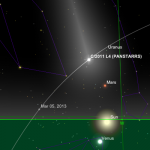
Initial predictions were quite optimistic with this comet, indicating a possible -1 magnitude for the comet. Reality seems to be somewhat more restrained, with a peak somewhere between magnitude one and two being more likely. Reports indicate that the comet has brightened to about 2nd magnitude, bright enough to be easily seen without optical aid.
Even more convenient, the comet will be well placed for observation this coming weekend. With new moon occurring on March 11th, this will be the prime weekend for a telescope outing. Amateur astronomers everywhere are already planing for this weekend. Our local club is no exception, expect a good crowd of telescopes to be at the Mauna Kea VIS this weekend. Myself? I will probably setup at the Substation site, just across the road from the VIS. The site offers a much better western horizon, which is blocked from the VIS by a line of pu’u, old cinder cones.
I will be taking photo gear, looking to get a decent photo of the comet. Stay tuned to Darker View to see the results if I meet with any success.
The latest orbital elements from the MPC
Another interesting opportunity will come on March 12th, when a slim crescent Moon will join the comet in the sky. A 1.4 day old moon, about 2% illuminated will be about 4° north (to the right) of the comet.
Another product of imaging earlier this week. Comet C/2012 K5 (LINEAR) is fading, but still bright enough to image. Right beside Orion it was well placed to target from my driveway. Just refreshing my comet hunting skills, getting ready for the show over the next few months as C/2011 L4 (PanSTARRS) comes into view.
